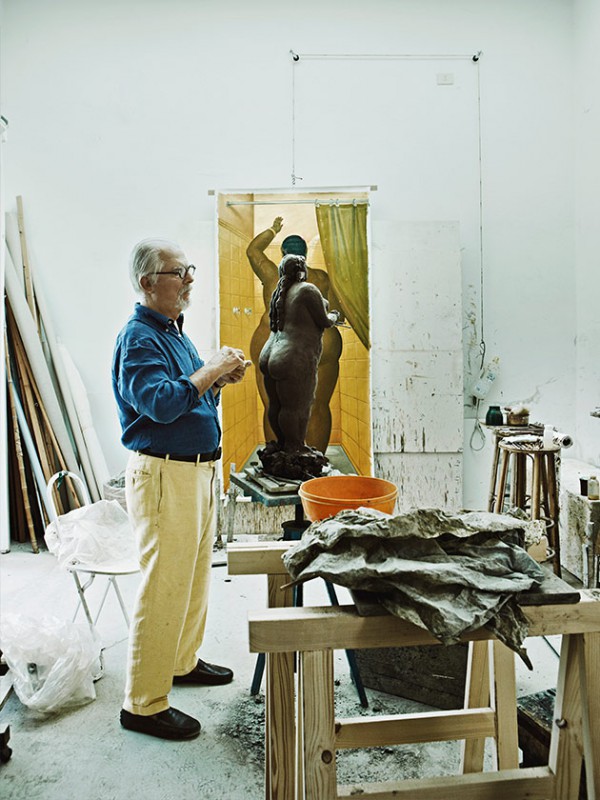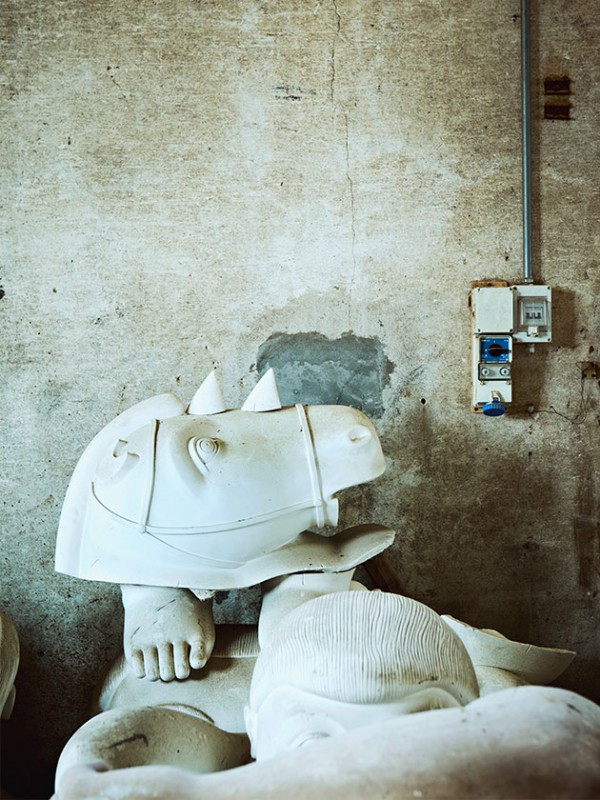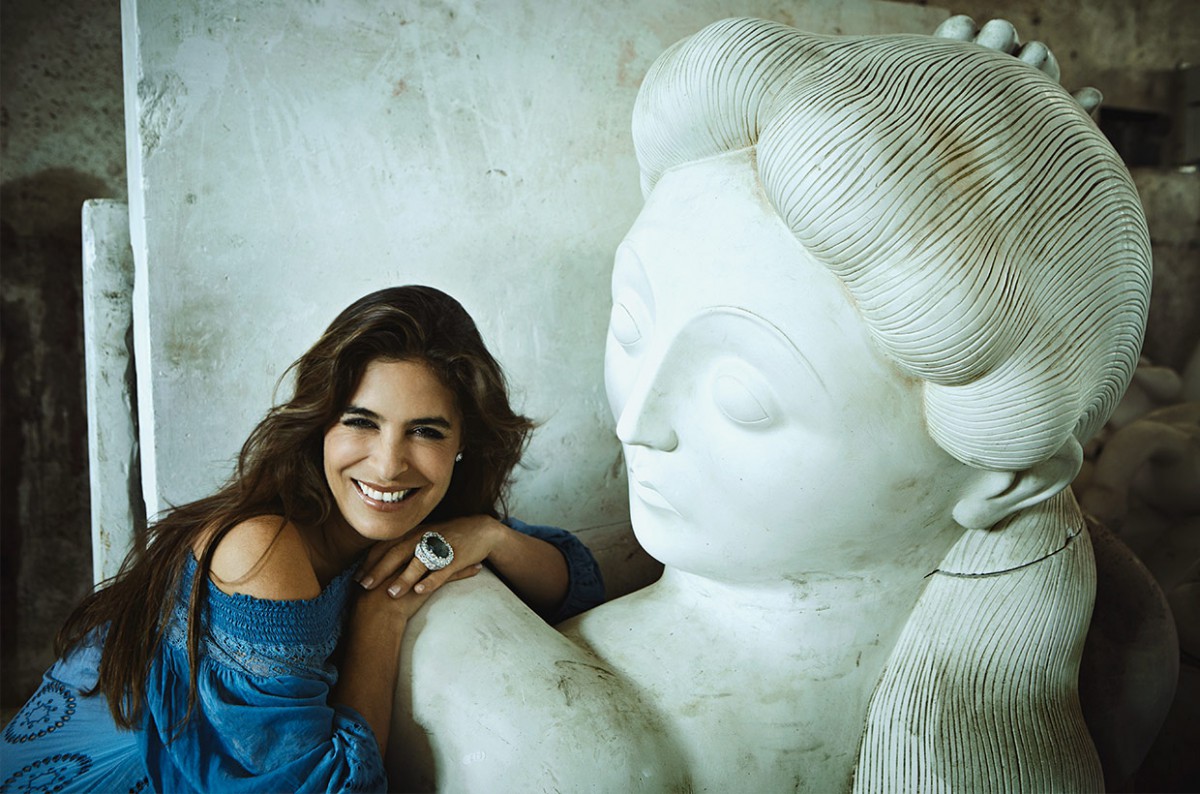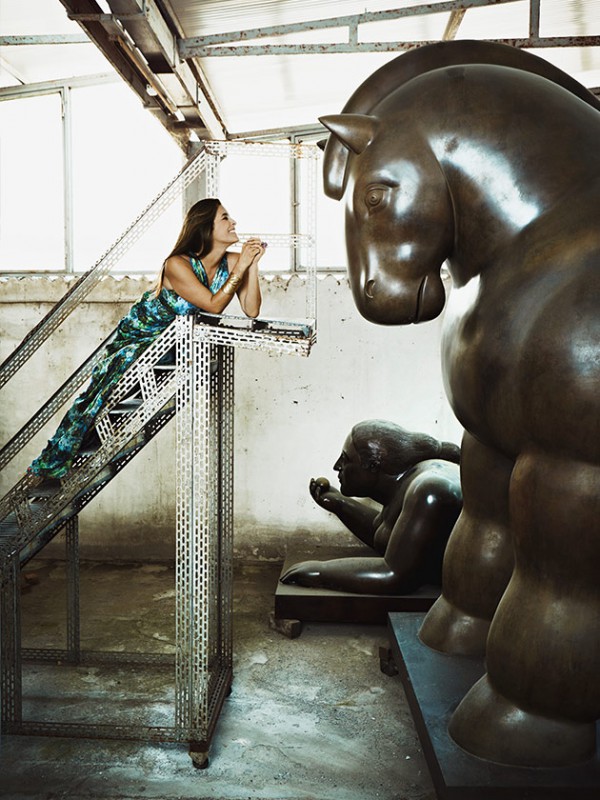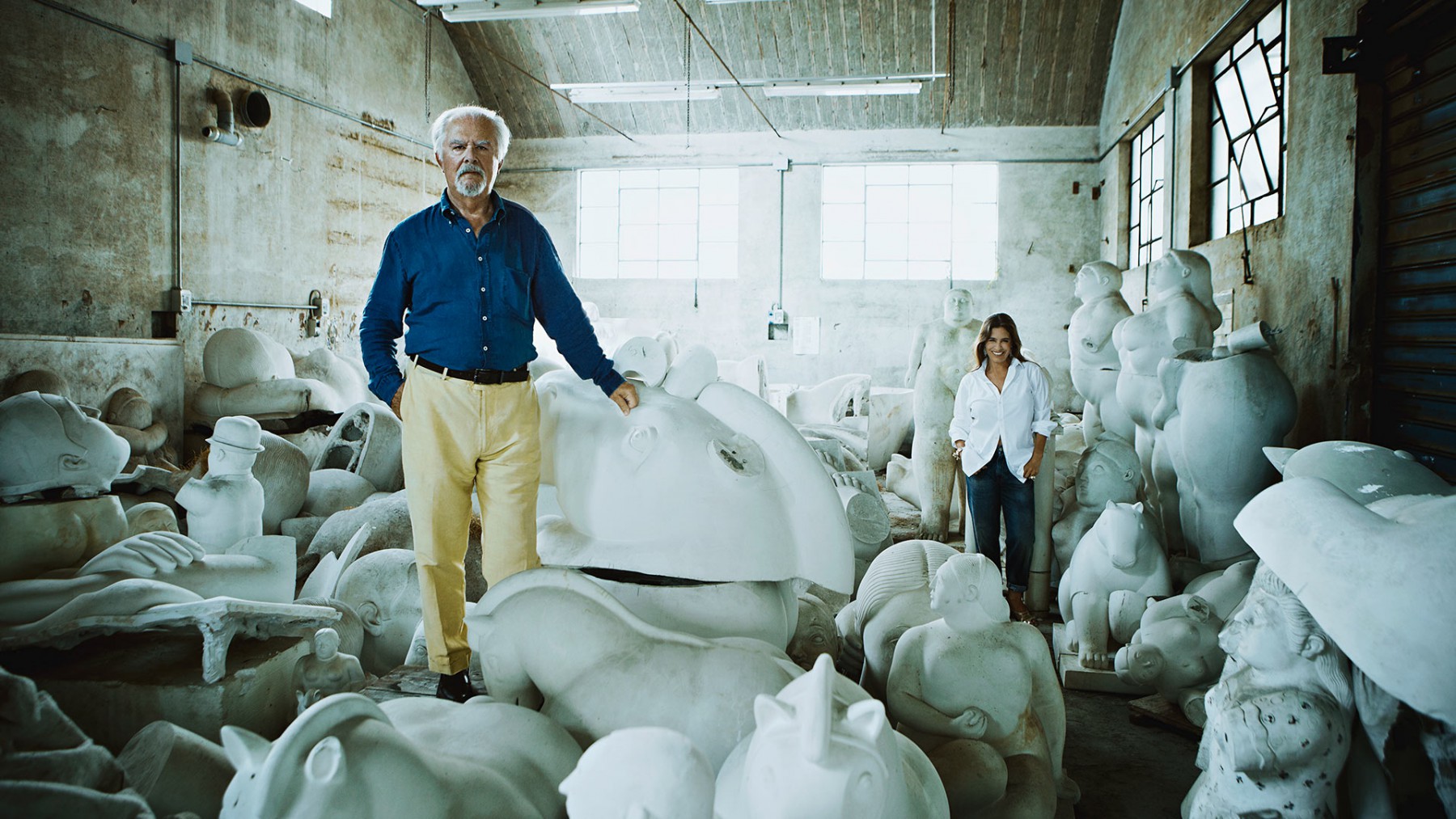My Father, Fernando Botero... by Michaela Cordes | 2nd March, 2011 | Personalities
Botero was only a little boy when he discovered his passion for art while painting matadors and bullfights in his home town Medellín. His long journey to be regarded as a fundamental artist and the memories of his personal struggles. An unusual conversation with the living legend and his daughter Lina…
The church clock in Pietrasanta strikes the happy hour and the piazza of this idyllic artists’ village not far from the marble quarries of Carrara gradually starts to fill with life. Close to the city of Pisa, Pietrasanta has been the hometown of famous stonemasons and sculptors ever since the days of Michelangelo, because it not only provides “holy stone” of the finest quality, but also the best foundries. One of the artists who calls this place home is Fernando Botero, the Latin American painter and sculptor famous for his unmistakable round and voluptuous figures that he originally painted and later cast in bronze as sensual statues of monumental dimensions. Today Botero is generally acknowledged as one of the world’s leading living artists and his works are at present enjoying an unprecedented surge in value fueled by the boom in the South American market. At Christie’s autumn auctions in New York last November his painting Family Scene fetched 1.7 million dollars, making Botero the leading figure among a whole group of popular Latin American artists. Fernando Botero arrives at the interview direct from his studio, looking very relaxed, and is accompanied by his daughter Lina, who buzzes around her father like a guardian angel, ordering a glass of water for him in fluent Italian, and occasionally pitching in a few anecdotes. The bond between them is so close that Lina sometimes seems to share her father’s feelings as he reminisces about earlier days.
“My childhood was totally magical. I grew up immersed in the art world. I love the smell of paint and turpentine to this day.” Lina Botero
She is a renowned interior designer who, based between Mexico, Colombia and Paris with projects on different continents, designs her own line of jewelry, too, and is currently working on a book on beautiful homes in Mexico. She is very active in the international art world, has been married twice and raised two children. “I have been working closely with my father over the last few years and enjoy my work with him immensely. It is an extraordinary privilege.” Over 60 exhibitions of Botero’s work in museums around the world have established him as a living legend. Despite their massive, monumental dimensions, his statues have traveled the globe from Paris to New York, and have been exhibited in over twenty major cities. They radiate a softness that makes people want to stroke them (like his Reclining Woman at Palma International Airport on the island of Majorca, whose left breast sparkles like gold from constant rubbing). Fernando Botero has always preferred to exhibit his creations in public places, for example, on the Champs-Elysées in Paris, seeing himself as a rebel who wanted his works to be accessible to the masses. But he has adhered strictly to the rules and traditions of the old masters in his techniques. He exudes a remarkably equable, orthodox aura. Today he’s wearing light yellow pants and a crisply ironed shirt and has round glasses perched on his prominent nose. It’s not easy to discern in him the usual stereotyped features of the tormented artist begging for recognition from an unresponsive world. Maybe he has acquired this self-assured stance from his very serious and detailed study of art.
He remains steadfast in his conviction that the old masters, especially the Italians, were the greatest. And his own style? Well, that came more or less naturally. Botero: “When I began to paint,I studied the Italian artists of the Quatrocento in Florence very closely, and understood the importance of beauty, volume and sensuality that was present in all their works. At the same time, I realized that the element of volume itself had almost disappeared in the 20th century. Art was two-dimensional and all about abstraction. So many things were taboo: Figurative art was wrong. Expressing your emotions was wrong. All the rich and extraordinary traditions of classical art were wrong. I ignored these rules and worked the way art history had taught me, seeking the sublime and the excellence that I had admired in the works of the great masters. The history of art is what authorized me to follow in the steps of those magnificent traditions of the past, although this was against everything that the contemporary art market was preaching.” Is it possible after so many years to remember how one’s style came into being for the first time in 1957 in the painting Still Life with Mandolin? Botero: “Yes, certainly. I was in my studio late at night and picked up a pencil to sketch a mandolin. I decided to make the hole much smaller than it should be, and the mandolin immediately became monumental. I later saw the same kind of nuance of proportion in paintings by Giotto of boys with little hands and little feet.” The typical Botero figure was born – voluminous and sensual.
When I mention the fame that he now enjoys, Fernando Botero smiles contentedly: “Yes, today… Everything is different today. I have enjoyed success and recognition. But I also went through difficult times, long years in which I worked very hard. To begin with, I was born in a country that had no museums, no collectors… just a huge, cultural void because there was no public funding for art. I sometimes wonder how I was able to get so involved in art with my original surroundings providing so little inspiration. I felt tremendous passion for art as a young child, and I was very much in love with what I saw, wanting to see more and more. When I was 15 I participated in art shows in my home town. At 17 I was painting professionally. At 19 I had my first one-man-show in Bogotá, and at 20 I won the national prize for painting in Colombia.” When did he realize that he wanted to be an artist? Botero: “I was very fond of bullfights, and started drawing the bulls and bullfighters. Perhaps that was my initiation. I eventually started talking to friends about Picasso and the Impressionists. They were very big then, and modern art in Colombia revolved around them. And so I started thinking about painting because that’s the direction you have to take with art. It starts with an intellectual idea of what art should be and then you improve your technical ability so that you can express your ideas.” It was later, during the ten years after he had left his home country that Botero had to weather strong criticism. Botero: “Abstract art and pop art were all the rage at the time, and everything was two-dimensional. Figurative art was totally out. I was doing the exact opposite of what the mainstream was preaching. My work was reminiscent of the old Renaissance masters whom I respected so much. I was interested in technique, in proportions, in the ability to draw.” Botero never gave up, perhaps due to his ability to cling to his vision. He was born into a poor family but was lovingly raised primarily by his mother. Botero: “We didn’t have a lot of money and my father died when I was four. I grew up in the years following the economic crisis and learned at an early age to do everything myself without anyone’s help. Looking at it that way, I was always a hard-working artist.” His mother supported her son’s unusual passion and she encouraged him to draw miniatures of the matadors in their colorful costumes. Botero: “Becoming a painter was not exactly what my mother had had in mind for me, but she said. ‘You are going to have a hard time, but if you love art, you should do it.’”
“Today my father is revered like a god in Colombia. But I still remember the struggles he went through in the very beginning…” Lina Botero
At age 17 Botero won an art prize in his home town, which awarded him 7,000 dollars. He used the money to go to Madrid to study the art of Velasquez, Goya, Titian and Tintoretto. Botero: “Staying at a hotel in Madrid cost me one dollar a night back then! The money lasted for almost three years.” He went from there to travel through Tuscany to Florence where he learned how to paint frescoes before going on to New York in 1960 and setting up home in Manhattan. Botero: “It took almost nine years for me to find a gallery that would exhibit my work.” It was the time when Andy Warhol was ushering in a new artistic era with his pop art. Daughter Lina can still remember those days: “My father arrived in New York, in what was then the art Mecca of the world, with 200 dollars in his pocket, three children and the will to do something important and make an impact. But although those were difficult times, I remember them as being magical. We didn’t have much money but my father compensated for that by telling us wonderful stories and engaging us in exciting activities. I loved the smell of paint and turpentine, and enjoyed it whenever he allowed me to watch him work. To see him being so in tune with himself and content while working on another piece of art made me always very happy.” Her father’s bitter disappointment when the Gres Gallery in Washington, D.C. had to close its doors shortly after his arrival in the USA made it very clear to her that her father was secretly fighting a battle for recognition. One event remains etched in her mind. Lina: “My parents got divorced three years after we moved to New York but my two brothers and I would visit my father as often as we could. He would set up three easels with three stools, paints and brushes so that we could be with him in his studio when he worked.” But then came his very first exhibition in New York at The Contemporaries gallery in 1961, and this brought some fierce criticism of his work. Lina: “Our three easels disappeared from one day to the next. I think what was going through my father’s mind was that he didn’t want his children to choose such a tough career for themselves. I still remember that incident very clearly.”
Success was dragging its heels. Barbara Duncan, who was responsible for young artists at New York’s Museum of Modern Art, did buy Botero’s Mona Lisa at the Age of 12 that same year. It was an important step forward, but in no way a breakthrough. That didn’t happen until 1970 when a German gallerist walked into Botero’s studio. Fernando Botero: “One day a very important man came by, Professor Dietrich Mahlow, a museum director from Germany. He happened to see one of my paintings in New York. He was thrilled, and asked me enthusiastically: ‘Do you have any more?’ Far too many, I replied. Then he and Professor Klaus Gallwitz, the director of the Frankfurt Museum, arranged five shows in Germany – in Weil, Bielefeld, Hanover, Hamburg and Berlin.” Infected by the strong interest shown by Germany, some of the big galleries in London and Paris started to turn their attention to the hot new South American artist and further exhibitions followed. Botero: “Marlborough, even Beyeler called. Today I feel as if I have had two lives: one that took place before the German exhibitions and one after…” Botero is today revered in his native Colombia like some sort of god. For many years now he has been doing his utmost to get his home town of Medellín known for something other than violence and drug trafficking, opening a museum there and donating his own art collection to the city. In 1977 he opened a hall in the Museo de Antioquia, dedicating it to his son Pedrito who was killed in a car accident in 1974 at the age of 4. Botero kept Pedrito alive in a collection of paintings he did after the accident. In the year 2000 he donated to his country his entire collection of impressionist, modern and contemporary art along with a very large collection of his own work, including 21 monumental sculptures. Botero is also well known as a philanthropist who has donated more than 600 works of art to Colombia and the United States, among other countries. His significant social contributions towards fighting famine, helping the elderly, and supporting young talents in music and the arts have been unprecedented. Nevertheless, Botero himself has not been immune to the violence that plagued his country in the 1980s and 1990s. Guerillas detonated a bomb at the foot of one of his sculptures in the main square in Medellín killing dozens of people. Botero immediately donated another sculpture exactly the same as the one that was destroyed and ordered them to remain side by side, reminding future generations of the barbarity of war, and the tenacity of peace. Can Fernando Botero today look back serenely on a colorful and eventful life, precisely because he soldiered on undauntedly in the face of the severe criticism and obstacles of his earlier years? Botero: “I’m sure that’s so. I don’t know what would have become of me if I hadn’t persevered despite the opposition.”
And today? Damien Hirst’s shark in formaldehyde spelled the end of any kind of rules governing contemporary art. What does Fernando Botero have to say about the art boom of recent years? Does he visit the art fairs at all? “I do, but I do not enjoy them really. Those art supermarkets, as I call them, very quickly become too much for me. I sometimes worry, because we’re not living in a very good time, I am afraid this century will not leave much of an impact on the greater scope of the history of art.” Are there any contemporary artists that he admires? “None whatsoever! I wish I could say otherwise. I know that my critical views make me unpopular, but it’s ridiculous what is called intellectuality today. Artists like Picasso were part of the greater evolution of art; his work was connected to that of Van Gogh or Cezanne. That’s what gave it substance, made is solid and today so valuable. Today it seems, any fast idea is turned into a piece of art, but mostly those are just glimpses of a moment, just like a fashion, a trend. They think that doing “something crazy” is art! But what else can you expect from those kids that come straight out of art school? How can you compare these young Americans with the old masters who spent a lifetime working toward excellence in art?”
